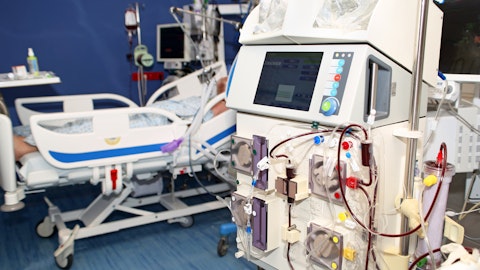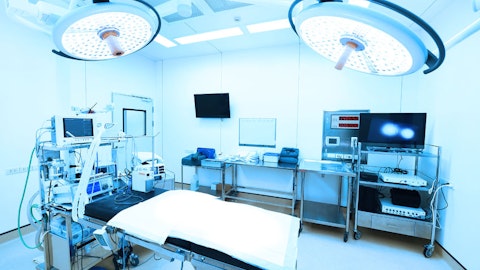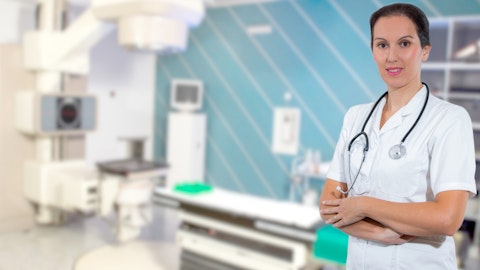Silk Road Medical, Inc (NASDAQ:SILK) Q3 2022 Earnings Call Transcript November 11, 2022
Operator: Good day, and thank you for standing by. Welcome to the Silk Road Medical 2022 Third Quarter Earnings Conference Call. At this time, all participants are in a listen-only mode. After the speakers’ presentation, there will be a question-and-answer session. Please be advised that today’s conference is being recorded. Now I would like to hand the conference over to one of your speakers today, Marissa Bych. Marissa, please go ahead.

Photo by Hush Naidoo Jade Photography on Unsplash
Marissa Bych: All right. Thank you for joining today’s call. Joining me are Erica Rogers, Chief Executive Officer; and Lucas Buchanan, Chief Financial Officer and Chief Operating Officer. Earlier today, Silk Road Medical released financial results for the three months ended September 30, 2022. A copy of the press release is available on the company’s website. Before we begin, I’d like to remind you that management will make statements during this call that include forward-looking statements within the meaning of the federal securities laws, which are made pursuant to the safe harbor provisions of the Private Securities Litigation Reform Act of 1995. Any statements contained in this call that relate to expectations or predictions of future events, results or performance are forward-looking statements.
All forward-looking statements including without limitation, those relating to our operating trends and future financial performance, expense management, expectations for hiring and growth in our organization, physician training and adoption, market opportunity and penetration, commercial and international expansion, regulatory approvals, reimbursement, competition and product development are based upon our current estimates and various assumptions. These statements involve material risks and uncertainties that could cause actual results or events to materially differ from those anticipated or implied by these forward-looking statements. Accordingly, you should not place undue reliance on these statements. For a list and description of the risks and uncertainties associated with our business, please refer to the Risk Factors section of our quarterly report on Form 10-Q filed with the Securities and Exchange Commission on August 9, 2022.
This conference call contains time sensitive information and is accurate only as of the live broadcast today, November 8, 2022. Silk Road Medical disclaims any intention or obligation except as required by law to update or revise any financial projections or forward-looking statements because of new information, future events or otherwise. With that, I will turn the call over to Erica Rogers, Chief Executive Officer.
Erica Rogers: Thank you, Marissa. Good afternoon, and thank you all for joining us. As pre-announced, we achieved revenue of $37.4 million in the third quarter buoyed by over 5,250 TCAR procedures representing 51% and 55% year-over-year growth, respectively. Two substantial drivers aligned for the first-time enabling our exceptional performance. First was a relatively more normal health care operating environment. And second, we began executing against the full addressable market in U.S. carotid artery disease treatment marking the early stages of an exciting trend and paving the way for ongoing momentum in TCAR adoption and utilization. Our strong commercial execution comes on the heels of recent FDA label and Medicare coverage expansions for the use of TCAR in standard surgical risk patients.
These achievements open up our addressable market to include all patients eligible for TCAR. We estimate this to be over 430,000 diagnoses and approximately 170,000 procedures annually representing a $3.2 billion opportunity in the U.S. Our expanded label supported by robust clinical evidence now in the tens of thousands of patients offers physicians a minimally invasive approach for all of their eligible patients who may benefit. In a sense, this was the first time in over seven decades that a minimally invasive procedure for carotid artery disease was on a level playing field with open surgery. And while a paradigm shift doesn’t happen overnight, we are encouraged by our early results as we push TCAR towards the standard of care. We know that every patient faces the risk of a surgical complication from invasive surgery and we are committed to driving increased awareness and adoption of the less invasive TCAR approach.
To that end, we maintain our patients first commitment with multiple campaigns underway to drive home the benefits of TCAR. These efforts are targeted towards both physicians and patients and include real-world patient stories and testimonials highlighting quality of life after TCAR, direct patients feedback, comparing recovery from TCAR versus CEA and social media and website strategies aimed directly at patients and their families, including through our bespoke patient portal protectionfromstroke.com. Momentum is building and positive feedback from our sales team and our customers is palpable. Physicians are now evaluating TCAR suitability for their patients based on their individual and unique clinical presentations rather than first screening for high surgical risk factors.
This enables superior care and a tangible shift in sentiment as more experienced TCAR users begin to extend their reach into a broader patient population. It remains early days, but we are excited to see many of our physicians increasing TCAR utilization. And in fact our most recent physician tracking survey, more than half of responders said it’s easier to choose TCAR when they don’t need to consider surgical risk criteria. In addition, we continue to see excellent momentum in clinical publications coming from the Vascular Quality Initiative or VQI with 55 publications in 2022 to date. For example, just last week at the VIVA conference, an analysis of over 124,000 VQI patients who underwent carotid revascularization between 2015 and 2020 was presented by Dr. Caitlin Hicks.
After adjusting for baseline demographic and clinical characteristics, the odds of perioperative stroke as well as combined stroke and death were lower for TCAR versus carotid endarterectomy in high surgical risk patients and similar in standard surgical risk patients. In both patient populations, TCAR patients had significantly lower odds of myocardial infarction than carotid endarterectomy. These data have now been published in the Journal of Vascular Surgery and the authors concluded that their data support the use of TCAR in standard surgical risk patients. Looking forward, as we build upon our robust clinical evidence base, enrollment in ROADSTER III, our post-approval study designed to assess the real world treatment of standard surgical risk patients, is underway with the first patient enrolled in early September.
As a reminder, this prospective single-arm study will enroll a maximum of 400 patients across roughly 60 leading clinical research sites and the primary endpoint is a composite of death, stroke or myocardial infarction through 30 days post procedure plus ipsilateral stroke from day 31 to 365 post-procedure. We are excited to add prospective data to the already compelling real world clinical evidence for TCAR in standard surgical risk patients and we look forward to updating you as the study progresses. Now I’d like to touch upon some of our key commercial metrics. As a reminder, we exited 2021 with a presence in nearly 1,000 hospital accounts that perform the majority of carotid procedures in the United States with a critical mass of almost 2,100 trained physicians served by 58 active sales territories.
And I am pleased to announce that we have hit our goal for active sales territories this year with ongoing training for the next tranche in sales reps underway. Regarding trained physicians, as we have at various periods in the past, we decided to react to the very strong demand for our educational programs and we now expect to exceed the high end of our goal of training 200 to 300 physicians this year. On the product innovation front, I am pleased to share the recent clearance of our ENROUTE Enflate Transcarotid Rapid Exchange Balloon Dilation Catheter or Enflate for short, the first balloon purpose built for TCAR and the fifth product in our TCAR portfolio. We are planning to begin a limited launch of Enflate this quarter rolling into a broader market release next year.
We do not expect measurable revenue from our limited release this year, but we do expect a slight lift in the procedural revenue for TCAR in 2023 and beyond. While we remain laser focused on the U.S. commercial opportunity, we are making progress with ongoing initiatives to expand our commercial presence into international markets. We recently received Shonin approvals in Japan for both our ENROUTE Neuroprotection System and the ENROUTE Stent. These approvals mark an important step towards penetrating the estimated $2.3 billion international market opportunity ahead of us. Our next steps include assessing the reimbursement process and post-market study requirements, which will further define our pathway and timeline to launch. We are also making steady progress in our non-feasibility trial in the setting of acute stroke thrombectomy.
Although, it remains early, we’ve already learned a lot about our potential here and our investigators are enthusiastic about the future of neuroprotection in transcarotid embolectomy. Turning to our outlook for 2022. We are raising our full year 2022 revenue expectations to a range of $134 million to $137 million and we now expect to exceed 19,000 total TCAR procedures performed this year, which would represent over 11% procedure share in the U.S. market. Lucas will provide further details on our outlook shortly. In summary, we are thrilled with our progress this year and feel momentum building for TCAR as a result of our growing commercial presence and recent label expansion. Having recently participated in World Stroke Day on October 29, we couldn’t be more excited about our long-term potential to reduce the devastating burden of stroke for patients and their families.
With that, I will turn the call over to Lucas Buchanan, our Chief Financial Officer and Chief Operating Officer.
See also 16 Biggest Car Companies By Revenue and The Future of Artificial Intelligence.
Lucas Buchanan: Thank you, Erica. Revenue for the three months ended September 30, 2022 was $37.4 million, a 51% increase from $24.7 million in the same period of the prior year. Growth was driven primarily by growing TCAR adoption. The number of TCAR procedures in the quarter was over 5,250 representing a 55% increase from the same period of the prior year. Adoption trends as measured by procedures per physician continued to increase across all quartiles of our trained physician base, not just quarters, but years from initial training. We know time and experience drives durable and growing adoption and we are excited about the future given our significant progress in training physicians over the last few years. As anticipated, our top users are leaning in early and many of them have already successfully performed a TCAR in a standard surgical risk patient.
We see significant greenfield opportunity remaining across our trained physician base. Gross margin for the third quarter of 2022 was 75%, equal to the third quarter of 2021. While we took on increased manufacturing overhead costs associated with our Minnesota facility, these costs were partially offset by the increased volume relative to the same period last year. Additionally, with Minnesota coming online for commercial production in this third quarter, this necessitated that we revalue our standard costs. The revaluation resulted in an increase in standard costs as we capitalized additional expense into our inventory balances thereby decreasing cost of goods sold and benefiting our gross margin in the quarter. With two manufacturing facilities now online for the ENROUTE Neuroprotection System, we continue to expect slightly lower full year 2022 gross margin as compared to 2021.
Total operating expenses for the third quarter of 2022 were $37.3 million, a 17% increase from $31.9 million in the third quarter of 2021. R&D expenses for the third quarter of 2022 were $8.5 million compared to $6.9 million in the third quarter of 2021. The increase in R&D spending was driven by growth in personnel as well as continued investments in ongoing product development and clinical programs. Sales, general and administrative expenses for the third quarter of 2022 were $28.8 million compared to $25 million in the third quarter of 2021. The increase in SG&A spending was driven primarily by growth in personnel and higher travel expenses in a more normalized environment relative to last year. We continue to expect a modest sequential increase in total operating expenses into Q4.
Net loss for the third quarter was $10.3 million, or a loss of $0.29 per share as compared to a net loss of $13.9 million or a loss of $0.40 per share for the same period of the prior year. We ended the quarter with $105.1 million of cash, cash equivalents and short-term investments and we are very pleased to have recently bolstered our balance sheet through the completion of a follow-on equity financing, which fully closed on October 25. This funding added almost $109 million in net proceeds to our balance sheet and provides substantial additional flexibility in support of our business and growth initiatives. Quickly touching upon our commercial progress. As Erica mentioned, we have hit our goal of reaching 70 to 75 active sales territories and we anticipate exceeding the high end of our prior guidance for 200 to 300 newly trained physicians in 2022, which would bring our total trained physician base to over 2,400.
With our commercial team expansion efforts, we continue to drive more touch points with physicians and we continue to see that increased engagement is an important driver of adoption. We have now seen sequential growth in procedures per physician per quarter for 4 straight quarters. On the operations front, we are making meaningful investments in our platform as we drive to operational excellence and scale with an eye toward a future of TCAR becoming the standard of care. Our manufacturing operations in Minnesota are officially online as of September with commercial ENROUTE Neuroprotection System units now in production alongside our existing manufacturing operations in California. The new facility enables a substantial step-up in manufacturing capacity and resiliency.
We also continue to work closely with our contract manufacturers, component and material suppliers and other vendors to manage and mitigate risk throughout our supply chain. Labor related issues continue to be a challenge with our vendors, which has manifested in longer lead times and cost pressures. That being said, I’m very proud of our team’s ability to manage and support our growth to-date as well as drive operating leverage into the future. Closing with our 2022 revenue guidance. As Erica mentioned, we now anticipate full year 2022 revenue to be in the range of $134 million to $137 million representing year-over-year growth of 32% to 35%. Commensurate with our revised outlook, we now expect full year 2022 procedures to be over 19,000 implying over 11% penetration of the core market.
Our revised guidance accounts for our strong performance year-to-date driven by growing tailwinds from therapy adoption as a result of our continued efforts to drive greater physician utilization and supplemented by our recent label expansion in the more normalized health care system operating environment. While we are not guiding beyond this year, we have said we expect standard surgical risk label expansion to provide a gradual layering effect to our growth in 2023 and beyond and that expectation remains intact. With that, I will hand it back to Erica for her closing comments.
Erica Rogers: Thank you, Lucas. I’d like to close by reflecting on a KOL event we recently hosted at our new facility in Plymouth, Minnesota. Across several physicians with varying levels of experience, two themes from the dialog were clear. First, the immense importance of decision-making based on data and clinical evidence with TCAR safety, efficacy and minimally invasive nature in focus. And second, the importance of the high patient satisfaction associated with TCAR. As we continue training and educating physicians about the benefits of TCAR and as we widen our approach to reach more patients, we are confident these themes will resonate steadily driving TCAR toward the standard of care. With that, we will open the line up to questions. Operator?
Q&A Session
Follow Silk Road Medical Inc (NASDAQ:SILK)
Follow Silk Road Medical Inc (NASDAQ:SILK)
Operator: Thank you. At this time, we will conduct a question-and-answer session. And our first question comes from the line of Robbie Marcus of JPMorgan. Please proceed with your question.
Unidentified Participant: Hi. This is Roman (ph) on for Robbie. My first question is just related to the updated guidance for this year. It implies a 4Q stepdown at the midpoint and I was just wondering if there was anything one-time in nature in this quarter or planned for fourth quarter that you could comment on that could kind of give us more color into this. Thanks.
Lucas Buchanan: Sure. I’m happy to take that one and give a little bit more color there. So I think it’s important to note that we do expect continued increases in procedures per physician and revenue per day and those types of metrics offset by slightly fewer selling days in Q4 relative to Q3. And our guidance also accounts for some kind of continued uncertainty and friction as you stack up kind of staffing shortages and pockets throughout the country, kind of the uncertainty of flu and COVID season, the typical holiday seasonality and to a lesser extent, some hurricane recovery in an important state in Florida. And so that gets us to roughly flattish at the midpoint as you point out and those are some of the puts and takes. But overall, the momentum in the business is strong.
Unidentified Participant: And then I guess another question is just what sort of contribution are you expecting next year from Enflate? And without providing obviously formal guidance, how should we be thinking about kind of growth and adoption in 2023?
Lucas Buchanan: I missed the first part of your question. Can you repeat that?
Unidentified Participant: Yeah, sorry. With the contribution from Enflate.
Lucas Buchanan: Okay. Got it. So on the balloon, we will have more to say on that at the Q4 call. Obviously we’re building up inventory and as we said in the prepared remarks, we’ll start a very limited launch here in Q4. The way to think about it is, it’s kind of the third accessory in the lineup of TCAR products. The stent and the neuroprotection system remain the flagship devices from an ASP and gross margin perspective, but the now three accessories all add to the speedies and the convenience and are important drivers of adoption of the therapy. And so there will be a modest lift to the kind of per procedure revenue opportunity and we’ll learn a little bit about utilization trends from the early market release and then into the broader market release later in 2023. So more to come on that front.
Unidentified Participant: Great. Thank you.
Operator: Thank you, Robert (ph). Our next question is going to come from Rick Wise of Stifel. Rick, please proceed with your question.
Rick Wise: Thank you very much. Erica, maybe just start off with a question I’ve asked you many times and I feel like your commentary at the start of this call sort of supports the idea that we really are at an inflection point. You’re encouraged by early results, you said momentum is building, many doctors are accelerating their TCAR use. Is this the moment where you’ve removed the sand from the gears and we can expect really significant acceleration from here?




